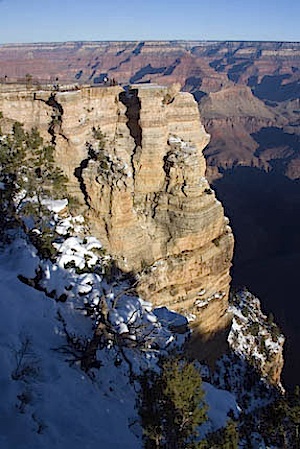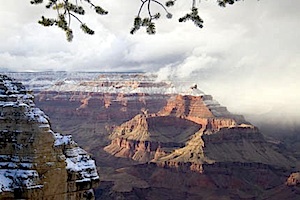From our snowy perch on Mather Point on the South Rim, the majestic formations of the Grand Canyon rise from the shadowy abyss below us. The morning sun washing through the canyon breaks the winter chill and saturates the reds, yellows, and oranges of the crests, buttes, and sinuous ridges. Gleaming in the morning’s warm light, the formations morph from distant cardboard cutouts into cosmic monuments and temples.
Snow from a recent storm covers the rim trail and cliffs below us, but not the towering formations. At lower elevations in the warmer Sonoran Desert zone deep in the canyon, they look little different from the spectacle that draws 4 million visitors during the warmer months. But now, between Christmas and New Year’s, we have plenty of elbow, and tripod, room on the viewpoints.
After soaking up the mind-expanding view, we stroll along the Rim Trail east toward the South Rim Village. Each bend presents a different vista accented with the snowy foreground and white-frocked juniper trees. I worked at the Grand Canyon one summer and visited the national park often while writing my iPhone and Android app guide to the Grand Canyon and Flagstaff. But I have never seen the Canyon cloaked in snow.
I live within a half-day’s drive, so when no major storms threatened the holiday week, my wife and I hit the road for a romantic white Christmas. Our plan is simple. Walk the Rim Trail east in the morning, have lunch and warm up in the Village, then catch the park shuttle back to our car at the Visitor Center.

A view down into the canyon from Mather Point. Photo by George Miller.
Since in the winter the Rim Trail west drive is open to public cars Hermit's Rest, we can drive to the viewpoints, leisurely check out each one, and end the day with sunset photos and dinner at a village restaurant. The following day we’ll take Desert View Drive and explore the eastern viewpoints and the ancient Tusayan Pueblo ruins.
The 10-mile-wide, one-mile-deep canyon runs generally east and west, so morning and afternoon light illuminates the inner canyon formations and mid-day light fills the side canyons that cut from the North Rim to the river. All of the 12 named viewpoints capture panoramic views up and down the immense canyon, but some are better for sunsets, others for sunrise.
The Rim Trail east viewpoints look westward so the formations glow in the morning light. Because of the orientation of the Rim Trail west viewpoints, west-facing ridges and buttes are closer and blaze with golden hues at sunset, especially at Hopi and Mohave points.
In canyon country, the sunset doesn’t fall, it rises. As the sun sinks toward the western horizon, shadows slowly creep up from the base of the formations to the tips. In turn the strata, each formed in a different geologic period, reflect the rich tones of the fading light. Shadows first darken in the Inner Gorge cut through 1.8-billion-year-old black basalt, the bedrock of the continent.
The rising inky shadow covers the brown slopes of eroded shale while the Redwall Limestone cliffs just above glow brilliantly. Like a vast drive-in movie, the scene changes minute by minute. Below us at Hopi Point, the light paints rich tones along a red-stone ridge that curves from the cliff. Distant tapered peaks capped with yellow limestone glow like beacons, then one by one blink out as the sun sets. Many people leave but the show continues for another 20 minutes. In the fading light, rich hues color the formations like a subtle wash of watercolors.

The view from Pipecreek Vista. Photo by George Miller.
From summer monsoon rains to winter storms, Grand Canyon weather often surprises. A brief snow storm hits the next morning. As planned we’re on the 28-mile Desert View Drive when the storm sweeps across the canyon. Breaks in the clouds shoot sunbeams across the formations like lasers. Clouds billow off the peaks in the canyon like steams of cotton candy. Fog rolls over us and the canyon disappears, then a few minutes later pops into view like magic.
By afternoon, the storm passes and sunlight fills the turquoise sky. Now, an elegant dressing of snow covers the top half of the inner-canyon formations. Nature’s commonplace miracle has transformed the canyon into a winter wonderland more grand than ever.
George Miller wrote the best-selling iPhone and Android app guide to the Grand Canyon and Flagstaff.


 Support Essential Coverage of Essential Places
Support Essential Coverage of Essential Places







Comments
Just be careful visiting in the winter. Sometimes the NPS will close HWY 64 through the park and won't notify anyone about it. It's happened to me twice and I didn't find out until I got all the way to the gate at Desert View. I had to turn around, drive the 27 miles back down to Cameron, the drive down to Flagstaff to get a room for the night. There was no sign posted anywhere when I turned onto 64 and the road conditions hotline didn't mention the closure either.
Best winter park!
Dear Opaca, HWY 64 through the park does close during bad weather. And this year, for some unknown reason, it was closed for weeks at a time, which in my humble opinion was ridiculous. However, I would like to point out that when you turned up highway 64 from Cameron, that you did indeed pass not one but TWO signs that told you the road was closed. Your failure or inability to read signs is not the fault of Grand Canyon National Park.